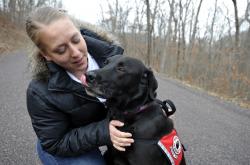Veterans Served by Wounded Warrior Project Share Their Service Dog Stories

JACKSONVILLE, Fla. (Sept. 28, 2017) – Dogs are well-known as “man’s best friend,” but for some of America’s service members, the bond goes much deeper. In celebration of National Dog Week, wounded veterans served by Wounded Warrior Project® (WWP) shared their stories about their service dogs, how the dogs have helped them cope with the visible and invisible wounds of war, and some tips for owning a service dog.
Army veteran Dozer Reed and his service dog, Leyna
How does your service dog assist you?
“My dog Leyna helps me on multiple fronts. For my mobility issues, she's acceptably defiant when she feels I am doing something I shouldn't. That happens frequently. She will bark to alert my family if my back locks up and I need assistance. For the other issues, she wakes me up when I’m having nightmares. She keeps a barrier around me in crowds or when walking. She distracts me when I get emotional or start to feel anxiety. Like any great dog, she loves me unconditionally. When I’m having a down day, she will cheer me up and get me back on that logical thought process. She's not great at talking, but that means she never lends her opinion unsolicited. On the flip side, she’s a great listener.”
What do you wish everyone understood about service dogs?
“When they’re with a wounded veteran, they’re working, and not just a pet. Service dogs are an assistive device like a wheelchair or a cane. I think people should realize there is nearly as much stigma around service dogs as there is with people dealing with post-traumatic stress. You can look at the dog, and above anything, talk to the handler. Some handlers allow their dogs to interact with the public, but a service dog by definition must perform a service. Remember, a service dog and a handler are a team. Respect and love your animal as you would any other teammate. Know when conditions aren't favorable for the animal, and be mindful of others as well.”
Are there any tricks to teaching a dog new commands?
“Kind of like with a child, trainers should practice praise and patience. Remember, these dogs have a short attention span. Work with them no more than 15 minutes at a time. Then give them a couple of hours as a break, and then go again for 15 minutes. Also, remember there's a language barrier, unless your barking is really good.”
Are there any other guidelines you’d give to a new dog owner to help them create a loving, happy pup?
“Puppies are cute, but that's where most people's affection stops. Treat your service dog like it’s part of the family, as if they were your child. Love them unconditionally, and they will reciprocate the sentiment.”
Army veteran Angela Peacock and her service dog, GI Joe
How does your service dog assist you?
“My service dog helped me get through college while helping me manage my anxiety in a healthier way than multiple medications. When I was at my worst, I would trust his calmness, and I learned to overcome severe agoraphobia. Now that he's older, he is semi-retired and helps me get out of the house when anxiety is high. He also wakes me from nightmares and provides the companionship I need while living alone. He worked full-time for eight long years and now enjoys long walks and frozen custard. Sounds like a great retirement to me. He's done so much to help my reintegration that it's hard to explain it all. I wouldn’t be the woman I am today without him.”
What do you wish everyone understood about service dogs?
“As many people know, service dogs are highly trained to assist disabled people with their disabilities. For some wounded veterans, like myself, it’s like our medication. It's a necessity to our life to try to live as normally as possible. It's a huge responsibility to keep our dogs highly trained and paying attention to us everywhere we go. I would warn others that if you approach, please don't pet, whistle, or pull their tails. You can ask us questions, but interrupting our dogs while they are working teaches them to pay attention to you instead of us. Please respect their job – it saves lives.”
What’s the best way to discipline a dog?
“Positive reinforcement is by far the best way to discipline a dog. Dogs who are praised for the behavior the owner does want instead of being punished for bad behavior is the best way. When dogs know they will get a toy, treats, or love, they will do anything for you.”
Are there any other guidelines you’d give to a new dog owner to help them create a loving, happy pup?
“Spend time with your dog. It's good for both of you. A walk around the neighborhood with make you healthier both physically and mentally and will help you bond with your dog. Sit in a park and give your dog a belly rub, and you'll feel calmer, and your dog will be happier.”
To learn and see more about how WWP’s programs and services connect, serve, and empower wounded warriors, visit https://newsroom.woundedwarriorproject.org, and click on multimedia.
Contact: Mattison Brooks – Public Relations
Email: mbrooks@woundedwarriorproject.org
Phone: 904.451.5590